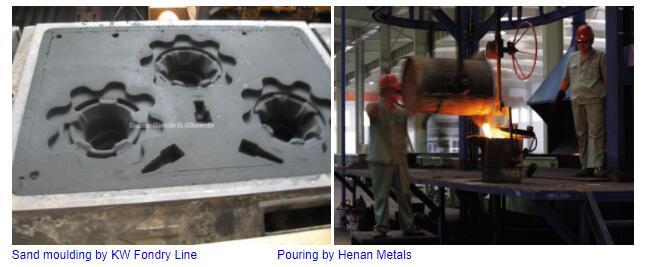
Introduction
Molding sand, also known as foundry sand, is sand that when moistened and compressed or oiled or heated tends to pack well and hold its shape. It is used in the process of sand casting.
In general, we can distinguish between two methods of sand casting; the first one using green sand and the second being the air set method.
Green sand
Green sand is an aggregate of sand, bentonite clay, pulverized coal and water. Its principal use is in making molds for metal casting. The largest portion of the aggregate is always sand, which can be either silica or olivine. There are many recipes for the proportion of clay, but they all strike different balances between moldability, surface finish, and ability of the hot molten metal to degas. The coal, typically referred to in foundries as sea-coal, which is present at a ratio of less than 5%, partially combusts in the surface of the molten metal leading to offgassing of organic vapors.
Sand casting is one of the earliest forms of casting practiced due to the simplicity of materials involved. It still remains one of the cheapest ways to cast metals because of that same simplicity. Other methods of casting, such as those using shell molds, boast higher quality of surface finish, but higher cost.
Green sand (like other casting sands) is usually housed in what casters refer to as casting flasks, which are nothing other than boxes without a bottom or lid. The box is split into two halves which are stacked together in use. The halves are referred to as the top (cope) and bottom (drag) flask respectively.
Not all Green sand is green in color. But considered "green" as in the sense that it is used in a wet state (akin to green wood). An alternative casting method is to heat-dry the molded sand before pouring the molten metal. This dry sand casting process results in a more rigid mold better suited to heavier castings. Unlike the name suggests, "green sand" is not a type of sand on its own, but is rather a mixture of:
silica sand (SiO2),
chromite sand (FeCr2O4), or zircon sand (ZrSiO4), 75 to 85%, sometimes with a proportion of olivine, staurolite, or graphite.
bentonite (clay), 5 to 11%
water, 2 to 4%
inert sludge 3 to 5%
anthracite (0 to 1%)

There are many recipes for the proportion of clay, but they all strike different balances between moldability, surface finish, and ability of the hot molten metal to degas. The coal, typically referred to in foundries as sea-coal, which is present at a ratio of less than 5%, partially combusts in the presence of the molten metal leading to offgassing of organic vapors. Green sand for non-ferrous metals does not use coal additives since the CO created is not effective to prevent oxidation. Green sand for aluminum typically uses olivine sand (a mixture of the minerals forsterite and fayalite which are made by crushing dunite rock). The choice of sand has a lot to do with the temperature that the metal is poured. At the temperatures that copper and iron are poured, the clay gets inactivated by the heat in that the montmorillonite is converted to illite, which is a non-expanding clay. Most foundries do not have the very expensive equipment to remove the burned out clay and substitute new clay, so instead, those that pour iron typically work with silica sand that is inexpensive compared to the other sands. As the clay is burned out, newly mixed sand is added and some of the old sand is discarded or recycled into other uses. Silica is the least desirable of the sands since metamorphic grains of silica sand have a tendency to explode to form sub-micron sized particles when thermally shocked during pouring of the molds. These particles enter the air of the work area and can lead to silicosis in the workers. Iron foundries spend a considerable effort on aggressive dust collection to capture this fine silica. The sand also has the dimensional instability associated with the conversion of quartz from alpha quartz to beta quartz at 1250 degrees F. Often additives such as wood flour are added to create a space for the grains to expand without deforming the mold. Olivine, chromite, etc. are used because they do not have a phase conversion that causes rapid expansion of the grains, as well as offering greater density, which cools the metal faster and produces finer grain structures in the metal. Since they are not metamorphic minerals, they do not have the polycrystals found in silica, and subsequently do not form hazardous sub-micron sized particles.
Keywords:
Message

Follow us
Henan Metal & Minerals I/E Co., Ltd.
welcomes friends from all over the world. We are always here waiting for your consultation.
Message
If you want to know more about our products, send a message to us, and we will get back to you within 24 hours.
Copyright © Henan Metals & Minerals I/E Co.,Ltd. All rights reserved